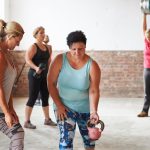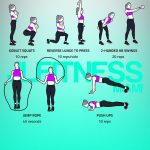Bodyweight exercises are crucial for boxers. They build strength, agility, and endurance without needing equipment.
Boxers rely on bodyweight exercises to enhance their physical capabilities. These exercises target different muscle groups, improving overall performance in the ring. Push-ups, pull-ups, squats, and burpees are staples in a boxer’s training regimen. Push-ups strengthen the chest, shoulders, and triceps.
Pull-ups build back and arm muscles. Squats enhance leg power and stability. Burpees provide a full-body workout, boosting cardiovascular fitness. Bodyweight exercises also improve balance and coordination, essential for swift movements. They are versatile, allowing boxers to train anywhere. Incorporating these exercises into a routine helps boxers stay in peak physical condition.

Credit: brawlbros.com
Introduction To Bodyweight Training For Boxers
Boxers need strength, agility, and endurance. Bodyweight exercises are perfect for them. These exercises use your own weight for resistance. No equipment is needed. This makes them convenient and effective.
Benefits For Combat Sports
Bodyweight training offers many benefits for boxers. Below are some of the key advantages:
- Improved Strength: Exercises like push-ups build upper body strength.
- Increased Endurance: High-rep sets boost muscular endurance.
- Better Agility: Movements like burpees enhance agility and quickness.
- Enhanced Coordination: Complex exercises improve hand-eye coordination.
- Injury Prevention: Strengthening muscles reduces injury risks.
Key Components Of An Effective Routine
An effective bodyweight routine should cover all aspects of fitness. Here are the main components:
| Component | Description | Example Exercises |
|---|---|---|
| Strength | Builds muscle power | Push-ups, squats |
| Endurance | Increases stamina | High-rep sets, circuit training |
| Agility | Improves movement speed | Burpees, jump squats |
| Coordination | Enhances control and precision | Plank to push-up, mountain climbers |
| Flexibility | Prevents injuries and aids recovery | Dynamic stretches, yoga poses |
To create a balanced routine, include exercises from each component. Rotate between strength and endurance workouts. Add agility drills and coordination exercises. Don’t forget flexibility training for recovery.

Credit: www.muscleandfitness.com
Core Workouts For Stability And Power
Building a strong core is essential for boxers. A solid core provides stability and power in punches and movements. Core workouts can enhance endurance and agility. Here are effective core exercises for boxers:
Plank Variations
Planks strengthen the entire core. They improve stability and balance. Try these plank variations:
- Standard Plank: Hold a plank position on your elbows and toes. Keep your body straight.
- Side Plank: Lie on one side. Lift your body using one elbow. Keep your body in a straight line.
- Plank with Shoulder Tap: Hold a standard plank. Tap your opposite shoulder with one hand. Alternate sides.
Russian Twists
Russian twists target the oblique muscles. They help in rotational strength:
- Sit on the floor. Lift your feet slightly.
- Hold a weight or medicine ball with both hands.
- Twist your torso to the right, then to the left.
- Keep your core engaged throughout the movement.
Leg Raises
Leg raises strengthen the lower abs. They improve core stability:
- Lie on your back. Keep your hands under your hips.
- Lift your legs towards the ceiling. Keep them straight.
- Lower your legs slowly without touching the floor.
- Repeat the movement for the desired number of reps.
| Exercise | Muscles Targeted |
|---|---|
| Plank Variations | Core, Shoulders, Glutes |
| Russian Twists | Obliques, Core |
| Leg Raises | Lower Abs, Core |
Lower Body Exercises For Explosive Movement
Boxers need explosive lower body strength for powerful punches and quick movements. Bodyweight exercises are key for building this strength. They improve agility, speed, and power without needing gym equipment. Below, we explore some effective lower body exercises for explosive movement.
Squats And Variations
Squats are a fundamental exercise for building lower body strength. They target the quadriceps, hamstrings, and glutes.
- Basic Squats: Stand with feet shoulder-width apart. Lower your body as if sitting in a chair. Keep your back straight and knees over toes.
- Jump Squats: Perform a basic squat. As you rise, jump explosively. Land softly and repeat.
- Pistol Squats: Stand on one leg. Lower your body while extending the other leg forward. This improves balance and strength.
Lunges
Lunges are excellent for building strength and stability. They work multiple muscle groups at once.
- Forward Lunges: Step forward with one leg. Lower your hips until both knees are bent at 90 degrees. Push back to the starting position.
- Reverse Lunges: Step backward with one leg. Lower your hips until both knees are bent at 90 degrees. Return to the starting position.
- Side Lunges: Step to the side with one leg. Keep the other leg straight. Lower your hips and push back to the starting position.
Box Jumps
Box jumps are perfect for developing explosive power in the legs. They enhance your jumping ability and overall athleticism.
- Basic Box Jumps: Stand in front of a sturdy box. Jump onto the box with both feet. Step down and repeat.
- Single-Leg Box Jumps: Stand on one leg in front of the box. Jump onto the box with one leg. Step down and switch legs.
- Depth Jumps: Stand on the box. Step off and land softly. Jump explosively upon landing.
These exercises build strength and enhance a boxer’s explosive power. Consistency is key for seeing improvements. Incorporate these movements into your training routine for optimal results.
Upper Body Drills For Punching Strength
Boxers need powerful punches. Upper body drills build that strength. These exercises use bodyweight only. They are simple yet effective.
Push-ups And Progressions
Push-ups are classic. They build chest, shoulders, and triceps. Strong chest and shoulders mean stronger punches.
Start with regular push-ups:
- Place hands shoulder-width apart.
- Keep your body straight.
- Lower yourself until elbows are at 90 degrees.
- Push back up.
Try these progressions:
| Progression | Description |
|---|---|
| Knee Push-Ups | Start on knees for less resistance. |
| Diamond Push-Ups | Hands close together to target triceps. |
| Plyometric Push-Ups | Push up explosively, hands leave the ground. |
Dips
Dips target triceps, shoulders, and chest. They help with punching power.
Find parallel bars or use two chairs:
- Grip the bars or chair edges.
- Lower your body by bending elbows.
- Stop when elbows are at 90 degrees.
- Push back up to the start.
Do 3 sets of 10-15 reps.
Pull-ups
Pull-ups are essential. They strengthen back, shoulders, and arms. A strong back helps with punch recovery.
Follow these steps for a proper pull-up:
- Grip a pull-up bar, palms facing away.
- Hang with arms fully extended.
- Pull your body up until chin is above the bar.
- Lower yourself back down slowly.
Do 3 sets of 5-10 reps.
Cardiovascular Conditioning Without Equipment
Boxers need strong cardiovascular conditioning. This helps them last through rounds. You don’t need equipment for this. There are many bodyweight exercises. These can boost your stamina and strength.
High-intensity Interval Training
High-Intensity Interval Training (HIIT) is a great way to improve your endurance. It involves short bursts of intense exercise. This is followed by rest periods.
- Warm up for 5 minutes.
- Sprint for 30 seconds.
- Walk or jog for 30 seconds.
- Repeat for 10-15 minutes.
HIIT boosts your heart rate quickly. It mimics the fast pace of a boxing match.
Shadow Boxing
Shadow boxing is another excellent exercise. It requires no equipment. It helps improve your speed and reflexes.
- Stand in your boxing stance.
- Throw punches in the air.
- Move around as if facing an opponent.
- Do this for 3-minute rounds with 1-minute rest.
Shadow boxing also enhances your footwork and coordination. It makes you more agile in the ring.
Burpees
Burpees are a full-body exercise. They are great for cardiovascular conditioning.
- Start in a standing position.
- Drop into a squat position.
- Kick your feet back into a plank.
- Do a push-up.
- Jump back to the squat position.
- Jump up with your arms raised.
Burpees work your muscles and heart. They improve your stamina and strength.

Credit: blog.pak-mma.com
Agility Ladders And Footwork Drills
Agility ladders and footwork drills are essential for boxers. These exercises boost speed, coordination, and agility. Agility ladders help boxers move quickly and precisely. Footwork drills improve balance and control. This combination enhances overall performance in the ring.
Incorporating Ladder Drills
Ladder drills are a key part of boxer training. They improve foot speed and precision. Here are some common ladder drills:
- High Knees: Run through the ladder, lifting knees high.
- In and Out: Step in and out of each square quickly.
- Side Steps: Move sideways through the ladder, keeping feet light.
These drills develop fast feet and better agility. Repeat each drill for 30 seconds, then rest for 10 seconds.
Plyometric Exercises
Plyometric exercises enhance explosive power. They are crucial for powerful punches. Here are some effective plyometric exercises:
- Box Jumps: Jump onto a sturdy box, then step down.
- Burpees: Perform a squat, jump, and push-up in one motion.
- Clap Push-Ups: Push up, clap hands, then land softly.
These exercises build strength and speed. Perform each exercise for 15 repetitions.
Balance Training
Balance training is vital for boxers. Good balance enhances stability and control. Balance exercises to include are:
- Single-Leg Stands: Stand on one leg for 30 seconds.
- Bosu Ball Squats: Squat on a Bosu ball, maintaining balance.
- Balance Board: Stand on a balance board, shifting weight slowly.
These exercises improve core strength and stability. Practice balance training daily for best results.
| Exercise | Benefits |
|---|---|
| Ladder Drills | Enhances foot speed and precision |
| Plyometric Exercises | Boosts explosive power |
| Balance Training | Improves stability and control |
Flexibility And Mobility Routines
Boxers need flexibility and mobility to perform at their best. These routines help prevent injuries and improve performance. Incorporating flexibility and mobility exercises into your training can make a significant difference.
Dynamic Stretching
Dynamic stretching involves moving parts of your body through a full range of motion. This type of stretching prepares your muscles for the intensity of boxing. Here are a few dynamic stretches:
- Leg Swings: Swing one leg forward and backward, then switch legs.
- Arm Circles: Make large circles with your arms, both forward and backward.
- Torso Twists: Rotate your torso from side to side with controlled movements.
Yoga Poses For Fighters
Yoga helps improve flexibility, balance, and mental focus. Certain poses are especially beneficial for boxers:
| Pose | Benefits |
|---|---|
| Downward Dog | Stretches hamstrings and shoulders, improves overall flexibility. |
| Warrior II | Strengthens legs, opens hips, and enhances balance. |
| Pigeon Pose | Targets hips, relieving tightness and increasing mobility. |
Myofascial Release Techniques
Myofascial release techniques help alleviate muscle tightness and improve blood flow. These methods involve applying pressure to specific areas:
- Foam Rolling: Use a foam roller on tight muscles for relief.
- Tennis Ball Massage: Roll a tennis ball under your foot or along your back.
- Trigger Point Therapy: Press on sore spots with your fingers or a massage tool.
These techniques can reduce muscle soreness and enhance recovery.
Recovery Strategies For Bodyweight Training
Boxers often rely on bodyweight exercises for strength and agility. Proper recovery is vital to prevent injuries and ensure peak performance. Implement these recovery strategies to maximize your training results.
Importance Of Rest Days
Rest days are crucial for muscle recovery. During rest, muscles repair and grow stronger. Skipping rest days can lead to overtraining and injuries.
Here are some key benefits of rest days:
- Muscle Repair
- Reduced Fatigue
- Mental Rejuvenation
Nutrition For Muscle Repair
A balanced diet aids muscle recovery. Focus on protein-rich foods, as protein repairs muscle tissue. Include carbohydrates for energy and fats for overall health.
| Food | Benefits |
|---|---|
| Chicken | High in protein |
| Quinoa | Rich in carbohydrates |
| Avocado | Healthy fats |
Hydration And Sleep
Hydration is essential for muscle function. Drink plenty of water to stay hydrated. Avoid sugary drinks and caffeine as they can dehydrate you.
Sleep is another critical factor. Aim for 7-9 hours of sleep each night. Quality sleep helps your body repair and refresh.
Integration With Boxing Techniques
Boxers need strength, agility, and quick reflexes. Bodyweight exercises help build these attributes. They also improve coordination and endurance. Integrating these exercises with boxing techniques can significantly boost performance.
Synchronizing Strength And Skills
Boxers should blend strength training with their boxing routines. This helps in creating a seamless connection between muscle power and technique.
- Push-ups: Enhance upper body strength. Combine with shadow boxing.
- Squats: Boost leg power. Pair with footwork drills.
- Planks: Develop core stability. Integrate with punching combinations.
Periodization For Fighters
Periodization is vital for boxers. It involves planning exercise routines in cycles to optimize performance and recovery.
| Phase | Focus | Duration |
|---|---|---|
| Preparation | Build endurance | 4-6 weeks |
| Strength | Increase power | 3-4 weeks |
| Pre-Competition | Refine skills | 2-3 weeks |
Mental Preparation
Mental strength is as crucial as physical strength for boxers. Bodyweight exercises can also aid in mental preparation.
- Consistency: Regular exercise boosts confidence and discipline.
- Focus: Mindful workouts improve concentration and reduce stress.
- Resilience: Overcoming physical challenges builds mental toughness.
Boxers should integrate bodyweight exercises into their training. This enhances both their physical and mental game.
Advanced Bodyweight Challenges
For boxers, mastering advanced bodyweight exercises can elevate their performance. These exercises target strength, balance, and endurance. They challenge your muscles in unique ways. Let’s dive into some advanced bodyweight challenges.
One-arm Push-up Mastery
The one-arm push-up is a test of strength and balance. It requires significant upper body power. Follow these steps to master it:
- Start in a regular push-up position.
- Place one arm behind your back.
- Lower your body slowly, keeping your core tight.
- Push back up, maintaining balance.
Practice regularly to improve. Your arm and core strength will increase.
Pistol Squat Proficiency
The pistol squat enhances leg strength and balance. It targets the quads, glutes, and hamstrings. Here’s how to perform it:
- Stand on one leg.
- Extend the other leg forward.
- Lower your body into a squat position.
- Keep your extended leg off the ground.
- Push back up to standing.
Repeat this for each leg. Consistency will help you gain proficiency.
Handstand Push-ups
Handstand push-ups are great for shoulder strength and balance. They also engage the core muscles. Here’s a guide to start:
- Find a wall for support.
- Kick into a handstand position.
- Lower your head towards the ground.
- Push back up to the handstand position.
Start with wall support. Gradually, try it without the wall.
Frequently Asked Questions
Are Bodyweight Exercises Good For Boxers?
Yes, bodyweight exercises are excellent for boxers. They enhance strength, agility, and endurance, crucial for boxing performance.
Did Mike Tyson Do Bodyweight Exercises?
Yes, Mike Tyson included bodyweight exercises in his training. He did push-ups, sit-ups, and neck bridges regularly.
Can Boxers Do Calisthenics?
Yes, boxers can do calisthenics. Calisthenics improves strength, endurance, and flexibility, which are crucial for boxing performance.
How Can I Strengthen My Body For Boxing?
To strengthen your body for boxing, focus on strength training, cardio, agility drills, core exercises, and proper nutrition.
Conclusion
Mastering bodyweight exercises can elevate a boxer’s performance. These workouts boost strength, endurance, and agility. They are equipment-free and can be done anywhere. Incorporate them into your routine for noticeable improvements. Embrace the simplicity and effectiveness of bodyweight training to become a stronger, more resilient boxer.






Comments are closed.